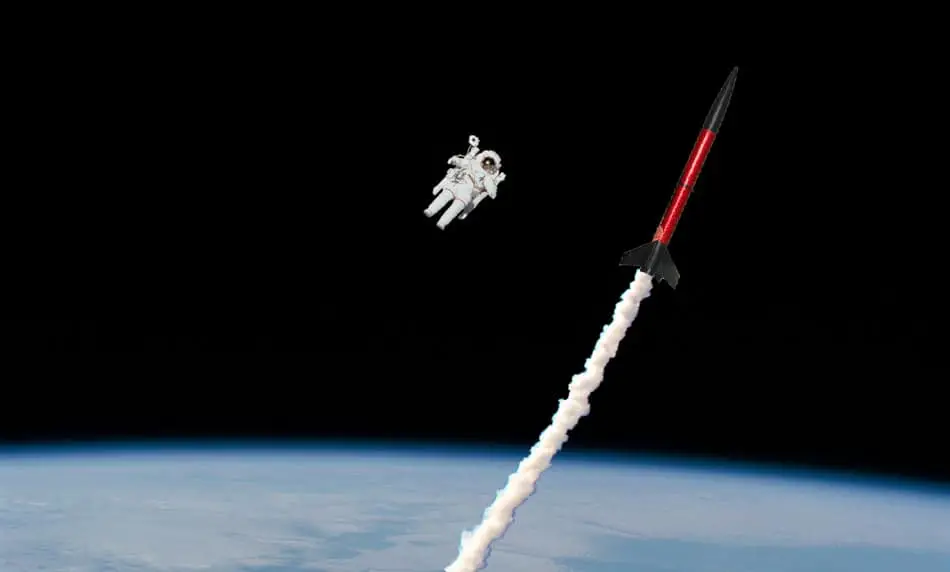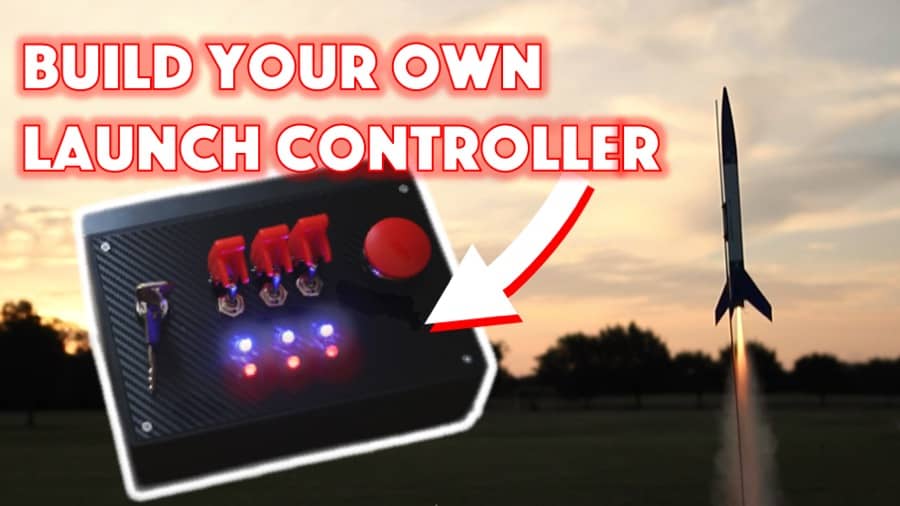
When it comes to model rockets, altitude is everything. Having seen model rockets shoot thousands of feet into the air, I started to wonder how high they can really fly.
What is a model rocket altitude limit? Model rockets don’t have regulations that limit altitude, but rather the weight of the rocket and amount of propellent. Most model rockets only reach altitudes of 200 to 2,000 feet but in 2004 a model rocket launched by the Civilian Space eXploration Team reached an altitude of about 72 miles high.
While launching a model rocket into space is possible, such a feat is rarely accomplished. In the rest of this article I will share with you all the details you will need to know before selecting the next high flyer as well as all the regulations that will impact just how high you can go.
Are you still using the standard Estes controllers for your launches?
We just built our own beautiful launch controllers that make launches SO much more fun, and we documented EVERY single step and item purchased and put it into a step-by-step course that teaches you how to do the exact same thing.
Click here to learn more about how you can build your own launch controllers!

Model Rocket Altitude
High altitude is achieved by building rockets that are both lightweight and aerodynamic and by using multistage engines that give the rocket the best chances for reaching the highest altitudes.
The highest flying rockets available through Estes, a very well known model rocket manufacturer, are the E2X Majestic (link to read reviews on Amazon) and the E2X Ascender (link to read reviews on Amazon). They can both reach an altitude of 3,000 feet when used with a booster.
The booster in these rockets allows a second engine to be used during flight which gives the rocket more power for longer.
High powered rockets of all kinds regularly reach altitudes of thousands of feet and sometimes tens of thousands of feet.
For the most part, the higher flying rockets are harder the build and require more sophisticated equipment to launch. Most casual model rocket flyers will only have the expertise to fly rockets that reach about 1,000 feet in altitude.
Model Rocket Features that Influence Max Altitude
If you’re shopping around for a model rocket that can reach high altitudes, then you probably already know that rockets come in a lot of different styles. In this section, I will give you the information you need about model rocket features that will allow you to select a high flyer.
Weight
When selecting a model rocket, it is best to go with something that is not too heavy or not too light.
The weight of a rocket will determine how much of the engine’s fuel it takes to launch it and to accelerate it. The faster the fuel is used up, the lower the altitude.
A lightweight rocket on the other hand will not have enough momentum after the engine burns out to coast effectively, and it may be more easily affected by the wind.
Aerodynamics
Aerodynamics plays a big role in how high a rocket can reach. Large, clunky rockets will not fly as high as slim streamlined ones.
The nose should be parabolic in shape according to the National Association of Rocketry.
Fin shape also matters. The best fin shape is, in theory, elliptical. For a great explanation on why that is, you can check out this edition of the Peak of Flight newsletter.
Also be sure to use a surface finish and sand down any wood pieces until they are absolutely smooth.
Engine
The engine that you use in a rocket plays a huge role in the kind of height you can achieve. According to the National Association of Rocketry, what you need to reach higher altitudes is the smallest engine that fits in your rocket with the highest total impulse, the longest time delay, and the lowest average thrust.
When selecting a model rocket engine, always refer to the recommended engines in the rocket’s owner’s manual.
Regulations that Limit Altitude
Model rocketry done well and following all regulations is a fairly safe hobby, but when people don’t follow the regulations, the situation can get unsafe fast.
The more powerful the rocket is, the more precautions you have to take because the consequences will be more dire.
While amateur model rocketry is virtually limitless in what it can accomplish, there are some hoops you need to jump through before you can launch a rocket thousands of feet into the air.
Many of the regulations put out by the National Association of Rocketry are also put out by the National Fire Prevention Association. Many states and local authorities use the codes and standards put out by the National Fire Prevention Association to set their fire codes.
So in some locations, not following these safety regulations could get you into trouble. Overall, the regulations are there to keep you safe and they are not unreasonable.
High Powered Engines
In order to reach those jaw dropping altitudes, you will need to use a higher powered model rocket engines.
There are limits placed upon what size model rocket engines your average citizen can purchase. In order to purchase higher powered model rocket engines, you must get certified. This prevents people who don’t know the basics of rocketry and safety from purchasing high powered engines and getting hurt.
First of all, to purchase an engine that is classified as higher than an F, you must be 18 years of age or older. If the engine has a metal casing, you need to be 18 years of age or older to purchase the engine regardless of the engine’s power.
There are three certification levels referred to as Level 1, Level 2, and Level 3 and the certification is granted through the NAR or through Tripoli.
- The Level 1 certification will allow someone to use H and I engines as well as the F and G engines that require certification.
- The Level 2 certification will allow someone to purchase J, K and L engines.
- The Level 3 certification allows the purchase of M, N, and O engines.
- An FFA permit or license is needed to use P, Q, R, and S engines. Anything beyond an S is not used in amateur rocketry.
Until you get certified, you’ll have to make do with the smaller engines, but even smaller engines can reach some pretty incredible heights if used in a well made model rocket.
Space Restrictions
Launching model rockets requires a lot of wide-open space to be done safely. This is why you see people launching frequently in football fields or in wide open deserts.
If you do not have access to a large open space free of buildings, trees, power lines, dry grass, or any other property that could be damaged, you will be limited on how high you can launch your model rocket.
If your model rocket is capable of reaching higher altitudes, there are extra precautions you will need to take because of the dangers of using a high powered engine, the potential for damage to people or property if a rocket loses control, and because of the potential for drift to carry the model rocket much further than you intended.
If you’re flying a basic model rocket, Estes recommends the following dimensions.
| Engine Impulse Class | Minimum Distance for Shortest Side | Altitude | ||
| 1/2A | 50 feet | 200 feet | ||
| A | 100 feet | 400 feet | ||
| B | 200 feet | 800 feet | ||
| C | 400 feet | 1,600 feet | ||
| D | 500 feet | 1,800 feet |
This chart shows the minimum shortest distance you would need depending upon which engine you are using and which altitudes you intend on reaching. The shortest minimum distance means that one side should be at least this length, and the others could be the same or greater.
For example, if you’re looking to launch a model rocket with an A engine, then you will need a site that is at least 100 by 100, or 10,000 square feet.
If you’re launching with even just the next engine up, a B engine, you will need a site that is at least 200 by 200 or 40,000 square feet. The launch site for the B engine would need to be 4 times larger than the launch site for the A engine.
A football field would likely only work for an A engine. The longest dimension might be 360 feet, but the width is only 160 feet. If you’re following the shortest side rule, then this would be too narrow for the B engine.
According to the NAR, the smallest dimension of the launch site should be 1,500 feet OR half the distance of the maximum projected altitude. You would need to use whichever number is larger.
That means if you expect your high powered rocket to launch 5,000 feet into the air, the shortest side of your launch site should be 2,500 feet.
Launch sites for high powered rockets should also be free of trees, power lines, building, bystanders and traffic. The higher you plan to launch the more space you will need.
FAA Waivers
Based on our research, most model rockets do not require that you get a waiver from the Federal Aviation Administration, but as you start to reach for higher altitudes and to use more powerful engines, you may find yourself in a situation where you need to contact the FAA about your planned launch.
You do not need to contact anyone, unless local laws state otherwise, if:
- Your rocket weighs less than 4 pounds.
- You are using less than 4 ounces of propellant.
You will not need a waiver, but you will need to contact the nearest FAA if:
- Your rocket weighs between 1 and 3.3 pounds.
- You are not using any more than 4.4 ounces of propellant.
You will need to file for a waiver with the FAA if:
- Your rocket weighs more than 3.3 pounds.
- You are using more than 4.4 ounces of propellant.
The FAA requires notification or waivers so that they do not mistake your rocket for a threat and so that they can ensure that the airspace is clear before you launch a rocket thousands of feet into the air.
A practical suggestion is to stick with the engines provided and sold by Estes. If you are wanting to build and launch rockets that use engines larger than that, be sure to join or consult with a local NAR club and they will be able to help mentor you in your larger rocket build. You are ultimately responsible for compliance with all local and federal laws that apply to model rocketry so getting some professional guidance is definitely recommended.
How to Estimate a Model Rocket’s Potential Altitude
Now that you know the restrictions that will impact the altitudes you can achieve; how do you know how high your model rocket can launch?
The easiest way, if you’ve bought an off the shelf rocket, is to check with the manufacturer or the place where you bought it. Estes lists the projected maximum altitude of all of their rockets. Apogee Components also lists data from its flight simulator for many of their rockets.
Speaking of simulators, you can also use rocket simulators likes the RockSim or OpenRocket to estimate the altitude your model rocket can fly. These are computer programs that will allow you to simulate the model rocket’s flight and predict statistics like the altitude and many more. They’re also a lot of fun.
If you’re a math whiz, you could also try out these formulas which will allow you to calculate how high you can expect your rocket to go. You learn a lot about your rocket’s potential using this method, but it is pretty complex.
Build Your Own Launch Controller
Don’t forget! You can ditch the stock controllers and confidently build your own from scratch using our step-by-step instructions and exact materials list! We promise this will make your launch experience 10x better, and using our course License to Launch you can be 100% confident you’ll be able to finish this project and be super proud of what you’ve built! Here’s a sneak peek below.
